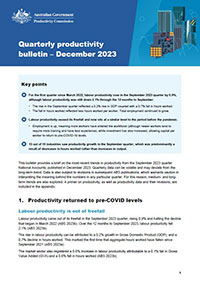Quarterly productivity bulletin – December 2023

PC productivity insights
This Bulletin unpacks the Australian Bureau of Statistics (ABS) December 2023 quarterly productivity statistics release and examines trends and new developments underlying Australia’s productivity performance.
Labour productivity came out of its freefall in the September quarter, returning to pre-pandemic levels. The report cautions that this is unlikely to reflect the beginning of a return to healthy long-term productivity growth, as the pre-pandemic level came at the end of a decade of relatively weak productivity growth.
Productivity bulletin: end of productivity freefall no cause for complacency
Australia’s labour productivity has halted its decline but mostly because people worked fewer hours in the 2023 September quarter, according to Productivity Commission research.
For the first quarter since March 2022, labour productivity rose – increasing by 0.9% in the September quarter, although labour productivity was still down 2.1% through the 12 months to September.
This increase in productivity was driven by a 0.7% decline in hours worked over the quarter coupled with relatively minor growth in GDP of 0.2%.
“The amount of hours worked has increased every month since September 2021. Now that growth in hours worked appears to have peaked without an accompanying decline in output, productivity has slightly recovered,” said Deputy Chair Dr Alex Robson.
Thirteen out of 19 industries saw productivity growth in the September quarter. Construction, along with the professional, scientific and technical services industry, contributed 0.7 percentage points to this growth, while administrative and support services decreased labour productivity by 0.2 percentage points.
The report says that this productivity result must be understood with reference to trends stemming from the COVID era.
“The COVID-19 pandemic created a ‘productivity bubble’ as workers temporarily moved away from low-productivity sectors, like hospitality, towards higher productivity sectors,” said Dr Robson.
“That bubble burst as workers returned to those lower productivity sectors when pandemic-related restrictions eased. In the wake of this, we are only now seeing labour productivity approach pre-COVID levels.”
As such, the report cautions that this recovery is unlikely to reflect the beginning of a return to healthy long-term productivity growth.
“Australia’s productivity returning to 2019 levels is no cause for complacency, as that level came at the end of a decade of relatively weak productivity growth,” said Dr Robson.
“It’s a further sign that the kind of sustainable long-term productivity growth Australia needs will require the type of policy reforms we highlighted in our Advancing Prosperity inquiry report.”
The latest Quarterly Productivity bulletin is available from: www.pc.gov.au/productivity-insights.
Media requests
Media team – 02 6240 3330 / media@pc.gov.au
- For the first quarter since March 2022, labour productivity rose in the September 2023 quarter by 0.9%, although labour productivity was still down 2.1% through the 12 months to September.
- The rise in the September quarter reflected a 0.2% rise in GDP coupled with a 0.7% fall in hours worked.
- The fall in hours worked reflected less hours worked per worker. Total employment continued to grow.
- Labour productivity ceased its freefall and now sits at a similar level to the period before the pandemic.
- Employment is up, meaning more workers have entered the workforce (although newer workers tend to require more training and have less experience), while investment has also increased, allowing capital per worker to return to pre COVID-19 levels.
- 13 out of 19 industries saw productivity growth in the September quarter, which was predominantly a result of decreases in hours worked rather than increases in output.
Media requests
Media team – 02 6240 3330 / media@pc.gov.au
Bulletin – December 2023
- Key points
- 1. Productivity returned to pre-COVID levels
- 2. More productive industries reduced hours worked
- Abbreviations
- References
- Copyright and publication detail
Appendix: Supporting data
- A primer on productivity
- Detailed productivity statistics
- Productivity data revisions
We value your comments about this publication and encourage you to provide feedback.
Related publications


